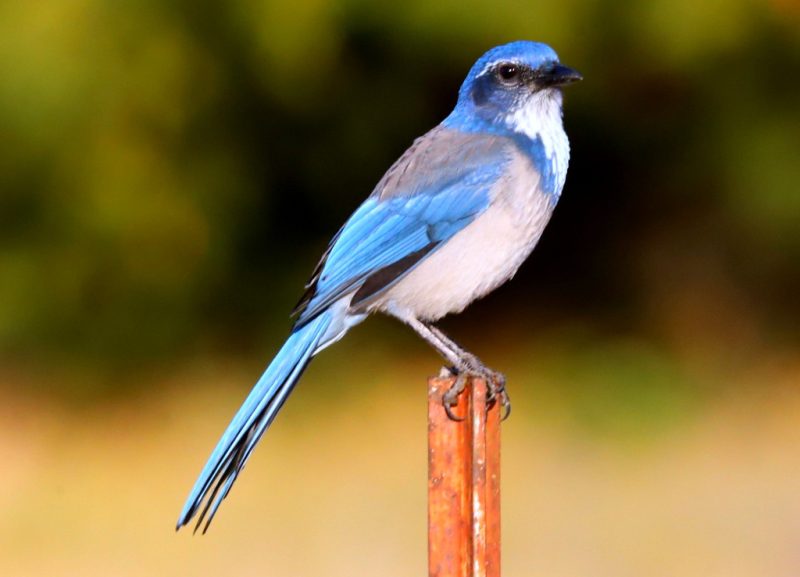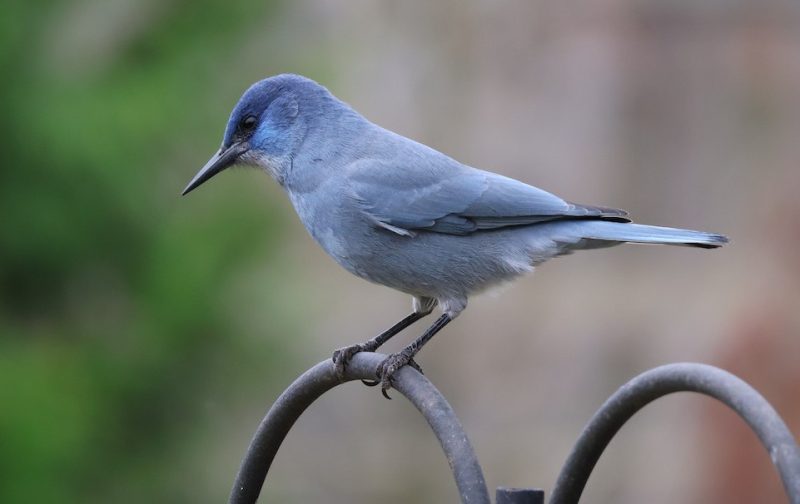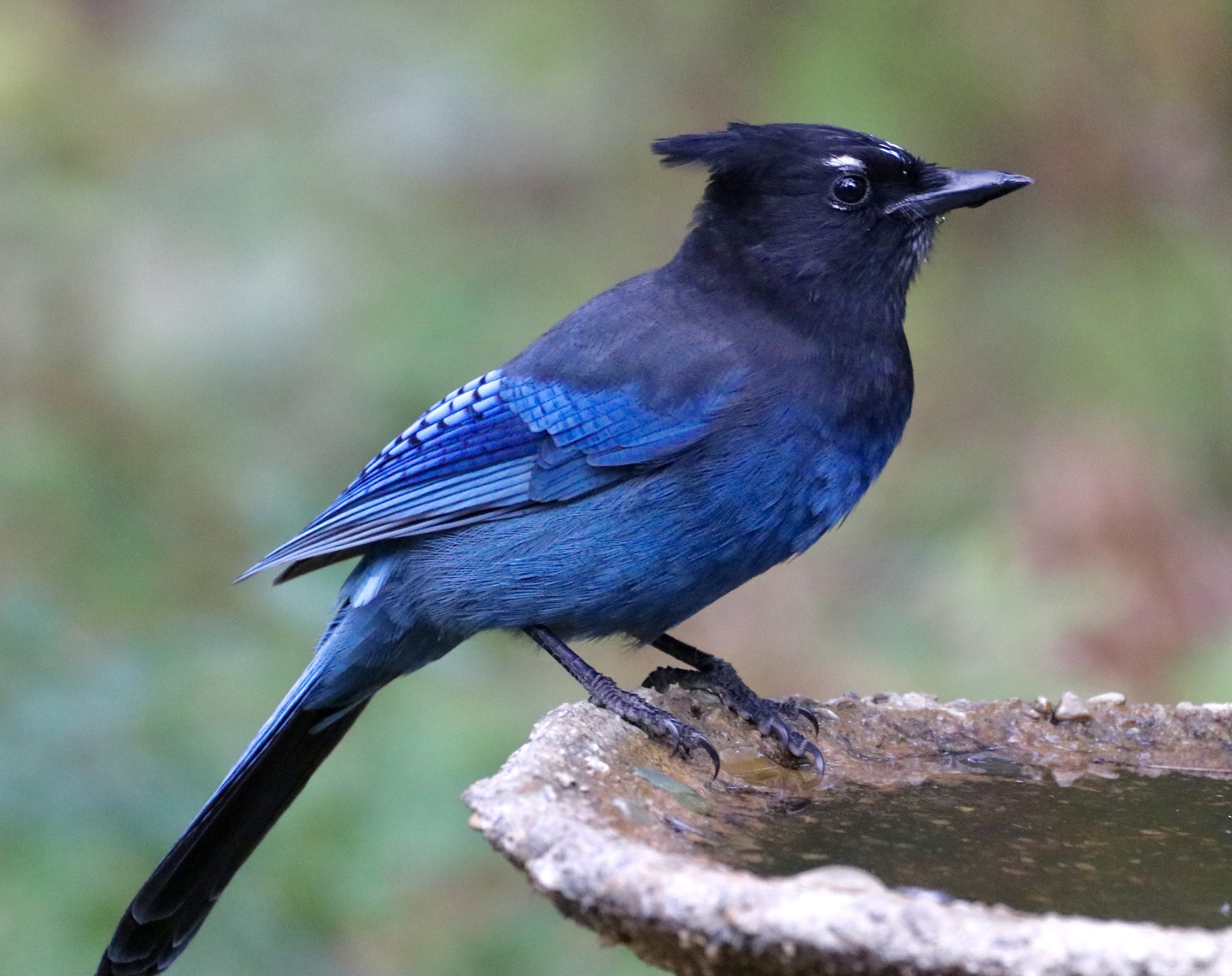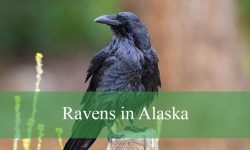Arizona’s diverse landscapes, from arid deserts to pine-covered mountains, provide an ideal environment for a wide variety of bird species. The state’s ecosystems offer abundant food, shelter, and nesting sites that attract both common and rare avian residents.
Among the most captivating birds in Arizona are the jays. These members of the Corvidae family are celebrated for their intelligence, striking plumage, and complex behaviors, making them a favorite among birdwatchers and nature enthusiasts alike.
This article explores three prominent jay species found in Arizona: the Western Scrub-Jay, Pinyon Jay, and Steller’s Jay. By providing detailed descriptions, identification tips, and fascinating insights, it aims to enhance your appreciation for these remarkable birds.
Western Scrub-Jay (Aphelocoma californica)

Western Scrub-Jay (Aphelocoma californica)
Identification and Physical Characteristics
The Western Scrub-Jay is a medium-sized songbird, typically measuring around 11 inches (28 cm) in length with a wingspan of about 15 inches (38 cm). Its plumage displays a striking combination of blue and gray. The head, back, and wings are pale to medium blue, while the throat and chest are soft gray, gradually fading into a white or light gray belly.
A distinctive white eyebrow stripe arches above the eye, sharply contrasting with the vibrant blue crown and nape. The bill is strong, straight, and black, ideal for prying open acorns and handling small prey. Its long, rounded tail provides balance while hopping among branches or foraging on the ground. Juveniles often have duller blue plumage and less pronounced eyebrow markings, making them slightly harder to identify in the field.
Behavior and Vocalizations
Western Scrub-Jays are renowned for their intelligence and problem-solving abilities. They produce a wide range of vocalizations, from harsh, metallic “shack” calls to soft, melodious notes used for communication within pairs or family groups.
These birds are bold and inquisitive, often approaching humans and exploring campsites, bird feeders, or urban gardens. They are active foragers, moving quickly between shrubs, trees, and the forest floor in search of insects, seeds, and small animals. Their social behavior includes aggressive displays to defend territory, as well as cooperative interactions with mates and offspring, reflecting a complex social structure.
Feeding Habits
Western Scrub-Jays are omnivorous opportunists. Their diet includes insects, small vertebrates such as lizards and nestling birds, fruits, nuts, and seeds.
They are particularly skilled at caching food, storing acorns and other items in multiple locations for later retrieval. Observations show that these birds remember hundreds of cache locations and can adjust their retrieval strategies based on the presence of other birds, demonstrating remarkable memory and strategic planning. During breeding season, they often increase insect consumption to provide protein for their chicks, highlighting their adaptability to seasonal changes in food availability.
Habitat and Distribution in Arizona
In Arizona, Western Scrub-Jays are commonly found in pinyon-juniper woodlands, pine-oak forests, and mixed vegetation areas that provide both foraging opportunities and protective cover.
They thrive in central and northern parts of the state, including the Mogollon Rim and surrounding highlands. These birds favor forest edges, open woodlands, and areas near water sources where food is abundant. While primarily non-migratory, local movements may occur in response to food availability, especially during harsh winters or droughts.
Fun Fact
Western Scrub-Jays are among the few non-human species capable of planning for the future. Scientific studies have shown they can anticipate future hunger and cache food strategically in safe locations.
This foresight, once thought to be uniquely human, highlights their advanced cognitive abilities. They have also been observed mimicking the calls of other birds and animals, and sometimes even human-made sounds, further illustrating their intelligence and adaptability.
Pinyon Jay (Gymnorhinus cyanocephalus)

Pinyon Jay (Gymnorhinus cyanocephalus)
Identification and Physical Characteristics
The Pinyon Jay is a medium-sized, crestless bird resembling a small crow. It measures approximately 11 to 12 inches (28–30 cm) in length, with a wingspan of about 16 to 17 inches (41–43 cm).
Its plumage is a uniform pale blue-gray, lacking the contrasting colors found in many other jay species. This subtle coloration helps the bird blend seamlessly into the pinyon-juniper woodlands it favors. The bill is stout, slightly dagger-shaped, and black, ideal for extracting seeds from pinyon cones. The tail is short and square, providing agility during flight and while foraging among dense foliage. Juveniles generally have slightly duller plumage, making them less conspicuous to predators.
Behavior and Vocalizations
Pinyon Jays are highly social birds, often forming large, noisy flocks ranging from a few dozen to several hundred individuals. These flocks move cohesively through woodlands, foraging together and maintaining constant vocal contact.
Their vocalizations include a variety of harsh, rattling calls and high-pitched whistles, used to coordinate movement, alert others to food sources, or signal potential threats. Pinyon Jays are cooperative by nature, frequently sharing information about abundant food and engaging in collective foraging strategies. Their complex social interactions reflect a high level of intelligence and sophisticated communication skills.
Feeding Habits
The diet of Pinyon Jays is highly specialized, focusing mainly on pinyon pine seeds. These birds are expert foragers, using their strong bills to extract seeds and transport them to safe caching sites.
Caching is critical for survival during periods when seeds are scarce. Pinyon Jays can remember hundreds of cache locations and retrieve seeds months later. This behavior not only supports their survival but also contributes to forest regeneration, as forgotten seeds can germinate and grow into new trees. In addition to pine seeds, Pinyon Jays occasionally eat berries, insects, and other small foods, especially when feeding their young.
Habitat and Distribution in Arizona
In Arizona, Pinyon Jays are closely associated with pinyon-juniper woodlands, most commonly found in the central and northern parts of the state, including the Mogollon Rim, highlands near Flagstaff, and the surrounding plateau regions.
Their distribution is tightly linked to the availability of pinyon pine seeds, which are vital to their diet. Habitat changes such as logging, drought, or wildfires can significantly impact their populations. They prefer open woodlands with scattered trees, which offer both foraging opportunities and safe perching sites.
Fun Fact
Pinyon Jays are known to mate for life, forming strong, long-term pair bonds. These bonds are reinforced through cooperative breeding, where offspring from previous seasons assist parents in feeding and protecting new chicks. This cooperative system enhances the survival of the entire family group and highlights the complex social structure of these remarkable birds.
Steller’s Jay (Cyanocitta stelleri)

Identification and Physical Characteristics
Steller’s Jay is a large and striking bird, easily recognized by its dark blue and black plumage. Its most distinguishing feature is the prominent black crest on the head, which creates a dramatic silhouette when perched or in flight. The body is predominantly dark blue, with lighter shades of blue on the wings and tail, creating a vivid and contrasting appearance.
The species measures between 11.8 to 13.4 inches (30–34 cm) in length, with a wingspan of about 17.3 inches (44 cm). The bill is strong and slightly curved, ideal for handling a wide variety of foods. Juvenile Steller’s Jays generally have duller coloration and a less defined crest, making adults more visually striking.
Behavior and Vocalizations
Steller’s Jays are bold, inquisitive, and highly active. They are often observed hopping across forest floors, perching conspicuously in trees, or exploring campgrounds and picnic areas.
Their vocalizations are loud and harsh, echoing through the coniferous forests where they reside. In addition to these calls, Steller’s Jays are skilled mimics. They can imitate the calls of other birds and occasionally human-made sounds, adding complexity to their vocal repertoire. Their curiosity and intelligence make them adept problem-solvers, frequently investigating new objects or potential food sources.
Feeding Habits
Steller’s Jays are omnivorous and opportunistic. Their diet includes insects, fruits, seeds, nuts, and small vertebrates such as lizards or nestling birds.
These birds are highly adaptable and will often take advantage of human food at campgrounds, picnic areas, and bird feeders. Their strong, versatile bills allow them to crack open hard seeds and nuts, which are particularly important during colder months. They also cache food when it is abundant, providing a critical resource during periods of scarcity. This combination of opportunistic feeding and food storage highlights their intelligence and adaptability.
Habitat and Distribution in Arizona
In Arizona, Steller’s Jays are typically found in coniferous forests at elevations ranging from 3,000 to 10,000 feet. They are most common in northern and central mountainous areas, including the Mogollon Rim, Flagstaff highlands, and parts of the White Mountains.
These birds prefer dense tree cover for protection from predators and ample foraging opportunities. They thrive in habitats dominated by pine, fir, and spruce trees, often near water sources and forest edges that support a rich diversity of insects, seeds, and fruits.
Fun Fact
Steller’s Jays are among the few bird species observed using tools. They have been seen employing twigs to extract insects from crevices in tree bark, demonstrating advanced problem-solving skills. Combined with their vocal mimicry and social intelligence, this behavior underscores their remarkable adaptability and cognitive abilities in the wild.
Comparison of the Three Jay Species in Arizona
Feature |
Western Scrub-Jay (Aphelocoma californica) |
Pinyon Jay (Gymnorhinus cyanocephalus) |
Steller’s Jay (Cyanocitta stelleri) |
|---|---|---|---|
Size |
Medium, 11 in (28 cm) length, 15 in wingspan |
Medium, 11–12 in (28–30 cm) length, 16–17 in wingspan |
Large, 11.8–13.4 in (30–34 cm) length, 17.3 in wingspan |
Plumage |
Blue head and back, gray underparts, white belly, white eyebrow stripe |
Uniform pale blue-gray, crestless, subtle coloration |
Dark blue body with lighter blue wings and tail, black crest |
Bill |
Black, straight, moderately strong |
Stout, dagger-shaped, black |
Strong, slightly curved, black |
Crest |
None |
None |
Prominent black crest |
Behavior |
Bold, curious, approaches humans, active forager |
Highly social, flocking, cooperative foragers |
Bold, inquisitive, investigates human areas, mimics calls |
Vocalizations |
Harsh metallic calls and soft melodious notes |
Harsh rattling calls and high-pitched whistles |
Loud, harsh calls, skilled mimicry of other species and sounds |
Diet |
Omnivorous: insects, seeds, fruits, small vertebrates; caches food |
Specialized on pinyon pine seeds; caches food; occasionally berries and insects |
Omnivorous: insects, seeds, nuts, fruits, small vertebrates; opportunistic feeders |
Habitat in AZ |
Pinyon-juniper and pine-oak woodlands, central and northern Arizona including Mogollon Rim |
Pinyon-juniper woodlands, central and northern Arizona, including Mogollon Rim and Flagstaff highlands |
Coniferous forests at 3,000–10,000 ft, northern and central mountains including Mogollon Rim and White Mountains |
Fun Fact |
Can plan for future needs and cache food strategically |
Mates for life; cooperative breeding enhances survival |
Uses tools to extract insects; mimics calls and human-made sounds |
Conclusion
Arizona’s diverse ecosystems support a rich variety of jay species, each with unique adaptations and behaviors.
From the intelligent Western Scrub-Jay to the social Pinyon Jay and the bold Steller’s Jay, these birds play vital roles in their habitats. Understanding their characteristics and behaviors not only enhances our appreciation of these remarkable creatures but also highlights the importance of conserving the varied environments they inhabit.
Whether you are an avid birdwatcher or a casual observer, encountering these jays in Arizona offers a fascinating glimpse into the intricate tapestry of life across deserts, woodlands, and mountain forests.
Frequently Asked Questions About Jays in Arizona
What are the main types of jays found in Arizona?
The three main species are the Western Scrub-Jay, Pinyon Jay, and Steller’s Jay, each exhibiting unique behaviors, diets, and habitat preferences across the state.
How can I identify a Western Scrub-Jay?
Western Scrub-Jays have blue heads and backs, gray underparts, a white belly, and a distinctive white eyebrow stripe that contrasts sharply with their blue crown.
Where do Pinyon Jays typically live in Arizona?
Pinyon Jays are primarily found in pinyon-juniper woodlands in central and northern Arizona, including the Mogollon Rim and Flagstaff highlands. They often move in large, noisy flocks while foraging.
What makes Steller’s Jays unique?
Steller’s Jays are large, dark blue birds with a prominent black crest. They are bold, highly inquisitive, skilled mimics, and have been observed using tools to obtain insects.
What do these jays eat?
All three species are omnivorous, consuming seeds, nuts, fruits, insects, and occasionally small vertebrates. Pinyon Jays specialize in pinyon pine seeds, which they also cache for later use.
When is the best time to observe jays in Arizona?
Early mornings and late afternoons are ideal times, as jays are most active during these periods for foraging and social interactions.






